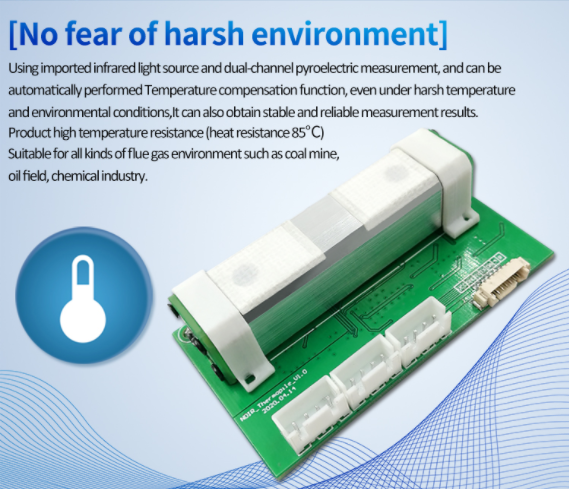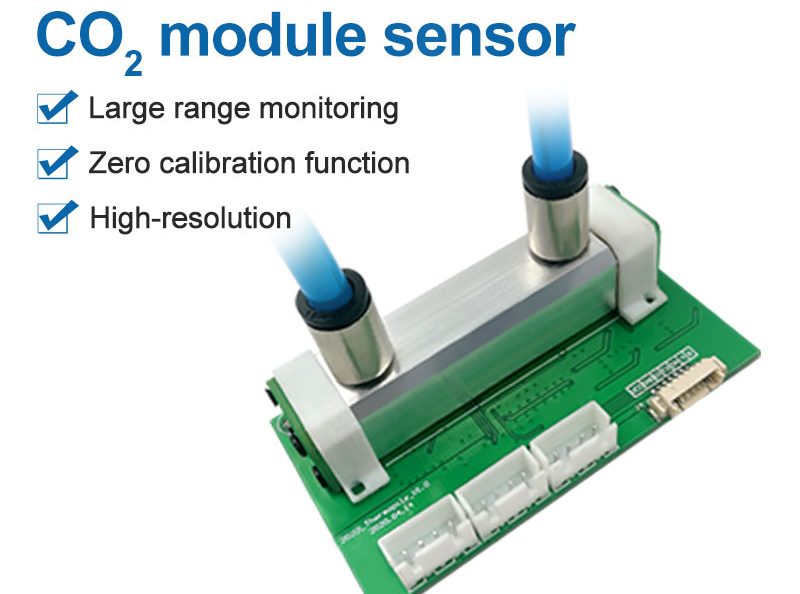NDIR gas sensor have become air quality management, offering precise and reliable detection of carbon dioxide levels in various settings. These advanced sensors play a critical role in ensuring healthy and sustainable indoor environments, as well as in industrial and agricultural applications. This article aims to provide a comprehensive exploration of NDIR CO2 sensors, their working principles, diverse applications, and the potential impact they hold for the future of environmental monitoring.
Working Principles of NDIR CO2 Sensor

NDIR CO2 sensor, often referred to as non-dispersive infrared (NDIR) sensors, operate based on the principle of infrared light absorption by CO2 molecules. These sensors consist of an infrared light source, a sample chamber, and a detector. When the infrared light passes through the sample chamber containing the gas to be measured, CO2 molecules absorb specific wavelengths of the light. The amount of light absorbed is then quantified by the detector, allowing for the accurate determination of CO2 concentrations. This working principle enables infrared CO2 sensors to provide precise and reliable measurements, making them invaluable tools for environmental monitoring and indoor air quality management.
Applications of NDIR CO2 Sensors

NDIR CO2 sensor find diverse applications across different sectors, including commercial buildings, residential spaces, industrial facilities, and agricultural environments. In commercial buildings, these sensors are integrated into heating, ventilation, and air conditioning (HVAC) systems to regulate indoor air quality and optimize energy efficiency. By continuously monitoring CO2 levels, the sensors enable HVAC systems to adjust ventilation rates, ensuring a healthy and comfortable indoor environment for occupants while minimizing energy consumption.
Moreover, in residential spaces, infrared CO2 sensor are support the operation of smart home automation systems, contributing to the well-being and comfort of residents. These sensors play a crucial role in monitoring indoor air quality and facilitating the implementation of energy-efficient ventilation strategies, thereby promoting sustainable living practices. In industrial facilities, infrared CO2 sensors are employed to monitor and control indoor air quality, particularly in areas where CO2 emissions may pose health and safety risks to workers. By promptly detecting elevated CO2 levels, these sensors enable the implementation of preventive measures to mitigate potential health risks and create a safe working environment.
In agricultural environments, infrared CO2 sensors are utilized to regulate CO2 levels in controlled atmosphere storage facilities, greenhouses, and livestock housing. These sensors play a pivotal role in optimizing plant growth, fruit ripening, and animal welfare, thereby enhancing the efficiency and sustainability of agricultural production. Additionally, in research and scientific applications, infrared CO2 sensors are utilized for environmental monitoring, climate research, and atmospheric studies, contributing to a deeper understanding of CO2 dynamics and their impact on the environment.
Impact and Future Prospects
The impact of infrared CO2 sensors on promoting sustainable and healthy indoor environments is significant. By enabling real-time monitoring and control of CO2 levels, these sensors contribute to the optimization of indoor air quality, energy efficiency, and occupant comfort. In commercial buildings and residential spaces, the integration of infrared CO2 sensors into HVAC systems allows for demand-controlled ventilation, leading to reduced energy consumption and lower carbon emissions. Moreover, in industrial facilities, these sensors play a crucial role in ensuring the health and safety of workers by monitoring and controlling indoor air quality.

Looking ahead, the future prospects of infrared CO2 sensors are promising. With advancements in sensor technology, these sensors are expected to become more compact, cost-effective, and versatile, further expanding their applications across various industries. Additionally, the integration of infrared CO2 sensors into smart building systems and IoT (Internet of Things) platforms will enable real-time data analysis and proactive control measures, leading to enhanced environmental sustainability and energy efficiency. Furthermore, ongoing research and development efforts are focused on improving the accuracy, sensitivity, and longevity of infrared CO2 sensors, paving the way for their widespread adoption in environmental monitoring and air quality management.
Conclusion
In conclusion, infrared CO2 sensors, based on non-dispersive infrared (NDIR) technology, have emerged as indispensable tools for enhancing environmental monitoring and indoor air quality management across diverse sectors. Their ability to provide accurate and reliable measurements of CO2 levels has transformed the way indoor environments are managed, promoting sustainability and the well-being of occupants. As the demand for sustainable and healthy indoor spaces continues to grow, infrared CO2 sensors, with their precise detection capabilities and broad applications, are poised to play a pivotal role in optimizing indoor air quality, energy efficiency, and overall environmental sustainability.
